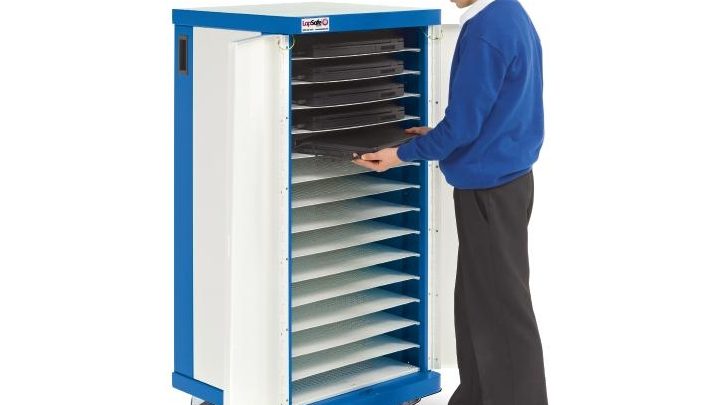Mobile Devices – How Are You Storing Yours?

A mobile devices strategy that doesn’t consider safe storage and charging is simply not fit for purpose, says Denise Crouch

If you are thinking of introducing multiple devices into the classroom, the hardest part must be choosing between the array of options available to you such as laptops, iPads, Android tablets, Chromebooks or Microsoft Surface; once you’ve done that, buying a trolley or cabinet to keep your gadgets safe and charged is simple, right? Well, no.
Over the last three years, numerous charging solutions have flooded into the marketplace, meaning that working out which will meet your needs and offer true value for money can be a real headache. Schools often take the easy option and buy the cheapest; but as we all know, that’s not always the wisest decision. So, before you rush off and make that mistake, here are a few points to consider:
Firstly, think about how your students will use the devices. Do you need to share them from one classroom to another? Will the devices need to be taken outdoors? How will you keep them secure when not in use? Are students going to bring in their own devices or would loaning out laptops or tablets be better suited to your learners?
Give some thought to your ICT technician: how will they manage updates and downloads to these devices? Will tablets need to be synchronised or do you need to add data transfer capability to network laptops?
All the options
There is a wide variety of solutions being offered from mobile trolleys and fixed wall cabinets to desk cabinets and small charging hubs. Most provide storage and charging for a range of devices and can cater for up to 60 of them. For loaning out devices or loaning individual charging bays there is a range of intelligent lockers that can be integrated with your library management system to loan the device in a similar way to a library book. This solution can work really well in a library and with very little interaction from the staff; students can borrow a device for a short period of time.
Once you have decided upon your preferred option, be it mobile or fixed, you obviously need to set a budget. When making a decision upon spend, consider the product’s life cycle and longevity; do you really want to buy cheap and then spend again in a year’s time or is it better to choose a solution that can be upgraded as your needs change i.e. as you refresh your devices?
Here are just a few important questions to help make your decision to buy a charging solution easier:
1. Does the laptop/tablet charging solution meet all of the British health nad safety electrical standards and also meet HSE safety guidelines?
2. Has the solution been tested for compliance by an independent body in the UK? Is it CE certified (some trolley manufacturers self-certify)?
3. Does it have safe power management as standard? Some trolleys have this as an option; safety should be mandatory.
4. Does the laptop/tablet trolley come with load protection (also known as ‘soft-start’ protection) as standard, to ensure that it does not trip circuit breakers when it is fully loaded?
5. Does the laptop/tablet trolley have surge protection, to ensure laptops aren’t damaged by any sudden fluctuations in electricity?
6. If using a data transfer function is there additional cooling provided with the unit to prevent overheating?
7. Is there fully integrated charging? This means the solution will have in-built charging leads made to match your specific make and model of device so there is no need for AC adaptors. Some integrated charging also shuts down the power after devices become fully charged to save energy and reduce carbon footprint.
8. Do you need to accommodate several different devices in one trolley or cabinet, or will students bring their own? If so, then choose a solution with easy cable management and one where AC adaptor store safely out of the way of students. Some trolleys allow you to ‘mix and match’ devices in one trolley or cabinet.
9. Will the trolley charge all devices simultaneously and do so in the fastest possible time? Some solutions use ‘round robin’ charging which only charges a few gadgets at a time or it limits the amount of charge to each device before moving on to the next.
10. If you are choosing a solution for tablets such as iPads, will the trolley accommodate them in their protective cases? Is there provision to protect devices from damage whilst they are stored on the shelves inside the unit, such as ‘grippy’foam that will prevent screens from being scratched? Any foam casing that holds an iPad in place during charging should be as snug as possible, without large gaps that could mean that the iPad moves around a lot during transport.
11. How secure is the unit? Ideally, you should choose a solution that comes fully assembled and is made of a fully welded steel chassis with no weak points such as plastic mouldings, or wooden panels or doors. Some come with enhanced security features such as built-in alarm, twin locking doors, high security keys and anti-drill locks. Additional features can include reinforced steel as well as anti-jemmy plates at risk points, to help combat against opportunist theft. Security loops to chain the trolley to the floor can give extra protection or choose a trolley with a docking station.
12. Does the laptop/tablet trolley have separate keys to unlock the front and back doors, for enhanced security and student safety?
13. What are the extra? Most trolleys come with various additional features, ranging from built-in 7 day timers, built in printers, network connectivity and data transfer.
Remember, you can spend a lot of time choosing the right devices for your school or college. So it’s worth taking just a bit more to decide on how to keep them safe, secure and fully charged.
About the author
Denise Crouch is head of sales and marketing at LapSafe @LapSafe www.lapsafe.com.







